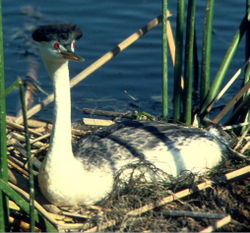|
Grebes |

Western Grebe
|
|
Scientific classification |
| Kingdom: |
Animalia
|
| Phylum: |
Chordata
|
| Class: |
Aves
|
| Order: |
Podicipediformes
Fürbringer, 1888 |
| Family: |
Podicipedidae
Bonaparte, 1831 |
|
| Genera |
Podiceps
Tachybaptus
Podilymbus
Aechmophorus
Poliocephalus
Rollandia
|
Grebes are members of the Podicipediformes
order, a widely distributed order of freshwater diving
birds, some of which visit the sea when
migrating and in winter. This order contains only a
single
family, the Podicipedidae, containing 20
species in 6
genera.
Grebes are small to medium-large in size, have lobed
toes, and are excellent swimmers and divers. However, they
have their feet placed far back on the body, making them
quite ungainly on land. They leave the water only to nest,
walking very short distances upright like
penguins. They can run for a short distance, but often
fall over.
Grebes have narrow wings, and some species are reluctant
to fly; indeed, two
South American species are completely flightless. They
respond to danger by diving rather than flying, and are in
any case much less wary than
ducks.
However, the
North American and Eurasian species are all, of necessity,
migratory over much or all of their ranges, and those
species that winter at sea are also seen regularly in
flight. Even the small freshwater Pied-billed Grebe of North America has occurred as a
transatlantic vagrant to Europe on more than 30 occasions.
Bills vary from short and thick to long and pointed; the
feet are always large, with broad lobes on the toes and
small webs connecting the front three toes. The hind toe
also has a small lobe. Recent experimental work has shown
that these lobes work like the
hydrofoil blades of a propeller. Curiously, the same
mechanism seems to have evolved independently in the extinct
Cretaceous-age Hesperornithiformes.
Grebes have unusual
plumage. It is dense and waterproof, and on the
underside the feathers are at right-angles to the skin,
sticking straight out to begin with and curling at the tip.
By pressing their feathers against the body, grebes can
adjust their
buoyancy. Often, they swim low in the water with just
the head and neck exposed.
In the non-breeding season, grebes are plain-coloured in
dark browns and whites. However, most have ornate and
distinctive breeding plumages, often developing chestnut
markings on the head area, and perform elaborate display
rituals. The young, particularly those of the
Podiceps genus, are often striped and retain some of
their juvenile plumage even after reaching full size.
When
preening, grebes eat their own feathers, and feed them to
their young. The function of this behaviour is uncertain but
it is believed to assist with pellet formation and to reduce
their vulnerability to gastric parasites.
The grebes share anatomical characters with and are
genetically most closely related to flamingos
Phoenicopteridae, in spite of their superficial
differences.
Species in taxonomic order
- Genus
Tachybaptus
- Little Grebe, Tachybaptus ruficollis
Australasian Grebe Tachybaptus novaehollandiae
Madagascar Grebe, Tachybaptus pelzelnii
Alaotra Grebe (Rusty Grebe), Tachybaptus rufolavatus
- probably extinct (late 1980s)
Least Grebe, Tachybaptus dominicus
- Genus
Podilymbus
- Pied-billed Grebe, Podilymbus podiceps
†Atitlán Grebe, Podilymbus gigas
Conservation status: Extinct (1989)
- Genus
Rollandia
- White-tufted Grebe, Rollandia rolland
Titicaca Flightless Grebe, Rollandia microptera
- Genus
Poliocephalus
- Hoary-headed Grebe, Poliocephalus poliocephalus
New Zealand Dabchick, Poliocephalus rufopectus
- Genus
Podiceps
- Red-necked Grebe, Podiceps grisegena
Great Crested Grebe, Podiceps cristatus
Slavonian Grebe or Horned Grebe, Podiceps auritus
Black-necked Grebe or Eared Grebe, Podiceps
nigricollis
†Colombian Grebe, Podiceps andinus
Conservation status: Extinct (1977)
Great Grebe, Podiceps major
Silvery Grebe, Podiceps occipitalis
Junin Flightless Grebe, Podiceps taczanowskii
Hooded Grebe, Podiceps gallardoi
- Genus
Aechmophorus
- Western Grebe, Aechmophorus occidentalis
Clark's Grebe, Aechmophorus clarkii
External links
References
- Grebes of our world by André Konter. Lynx
Edicions. 187 pages.
ISBN 84-87334-33-4




